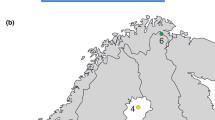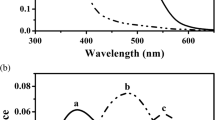Summary
-
1.
The visual pigments of 27 species of crabs from a variety of habitats were investigated by microspectrophotometry of the isolated rhabdomeric photoreceptors. The rhodopsins ranged inλ max from 473 to 515 nm (Tables 1 and 2). No evidence was found for the presence of more than a single rhodopsin in retinular cells 1–7.
-
2.
All rhodopsins produced thermally stable metarhodopsins on irradiation with long-wavelength light. The metarhodopsins of hermit crabs (Anomura: section Paguridea) all absorbed hypsochromically to their rhodopsins. Brachyuran metarhodopsins. with the exception of that ofCancer irroratus, absorbed at the same spectral position as the rhodopsin or bathochromically to it.
-
3.
The absorption spectra of all rhodopsins but one could be fit closely by the Dartnall nomogram. Since prior studies have located only retinal in the eyes of crabs, retinal may serve universally as a chromophore in crab visual pigments
Similar content being viewed by others
Abbreviations
- MSP :
-
microspectrophotometry
References
Arikawa K, Kawamata K, Suzuki T, Eguchi E (1987) Daily changes of structure, function, and rhodopsin content in the compound eye of the crabHemigrapsus sanguineus. J Com Physiol A 161:161–174
Baylor DA, Lamb TD, Yau K-W (1979) The membrane current of single rod outer segments. J Physiol 288:589–611
Briggs MH (1961) Visual pigment of grapsoid crabs. Nature 190:784–786
Bruno MS, Goldsmith TH (1974) Rhodopsin of the blue crabCallinectes sapidus: Evidence for absorption differences in vitro and in vivo. Vision Res 14:653–658
Bruno MS, Mote MI, Goldsmith TH (1973) Spectral absorption and sensitivity measurements in single ommatidia of the green crab,Carcinus. J Comp Physiol 82:151–163
Bruno MS, Barnes SN, Goldsmith TH (1977) The visual pigment and visual cycle of the lobster,Homarus. J Comp Physiol 120:123–142
Cavenaugh GM (1956) Formulae and methods of the marine biological laboratory chemical room. Woods Hole, Massachusetts
Crescitelli F, McFall-Ngai M, Horwitz J (1985) The visual pigment sensitivity hypothesis: further evidence from fishes of varying habitats. J Comp Physiol A 157:323–333
Cronin TW (1985) The visual pigment of a stomatopod crustacean,Squilla empusa. J Comp Physiol A 156:679–687
Cronin TW (1986) Photoreception in marine invertebrates. Am Zool 26:403–415
Cronin TW, Goldsmith TH (1982) Quantum efficiency and photosensitivity of the rhodopsin-metarhodopsin conversion in crayfish photoreceptors. Photochem Photobiol 36:447–454
Cummins DR, Goldsmith TH (1981) Cellular identification of the violet receptor in the crayfish eye. J Com Physiol 142:199–202
Dartnall HJA (1953) The interpretation of spectral sensitivity curves. Brit Med Bull 9:24–30
Dartnall HJA (1972) Photosensitivity. In: Dartnall HJA (ed) Photochemistry of vision (Handbook of sensory physiology, vol VII/1). Springer, Berlin Heidelberg New York, pp 122–145
Denton EJ, Warren FJ (1956) Visual pigments of deep-sea fish. Nature 178:1059
Ebrey T, Honig B (1977) New wavelength dependent visual pigment nomograms. Vision Res 17:147–151
Fernandez HR (1973) Spectral sensitivity and visual pigment of the compound eye of the galatheid crabPleuroncodes planipes. Mar Biol 20:148–153
Forward RB Jr, Cronin TW, Douglass JK (1987) The visual pigments of crabs. II. Environmental adaptations. J Comp Physiol A 162:479–490
Goldsmith TH (1972) The natural history of invertebrate visual pigments. In: Dartnall HJA (ed) Photochemistry of vision (Handbook of sensory physiology, vol VII/1). Springer, Berlin Heidelberg New York, pp 685–719
Goldsmith TH (1978) The effects of screening pigments on the spectral sensitivity of some Crustacea with scotopic (superposition) eyes. Vision Res 18:475–482
Goldsmith TH, Bernard GD (1985) Visual pigments of invertebrates. Photochem Photobiol 42:805–809
Goldsmith TH, Wehner R (1977) Restrictions on rotational and translational diffusion of pigment in the membranes of rhabdomeric photoreceptor. J Gen Physiol 70:453–490
Hays D, Goldsmith TH (1969) Microspectrophotometry of the visual pigment of the spider crabLibinia emarginata. Z Vergl Physiol 65:218–232
Hochstein S, Minke B, Hillman P, Knight BW (1978) The kinetics of visual pigment systems. I. Mathematical analysis. Biol Cybern 30:23–32
Hobson ES, McFarland WN, Chess JR (1981) Crepuscular and nocturnal activities of Californian nearshore fishes, with consideration of their scotopic visual pigments and the photic environment. Fish Bull 79:1–30
Hyatt GW (1975) Physiological and behavioral evidence for color discrimination by fiddler crabs (Brachyura, Ocypodidae, genusUca) In: Vernberg FJ (ed) Physiological ecology of estuarine organisms. University of South Carolina Press, Columbia SC, pp 333–365
Jameson D (1972) Theoretical issues of color vision. In: Jameson D, Hurvich LM (eds) Visual psychophysics (Handbook of sensory physiology, vol VII/4), Springer, Berlin Heidelberg New York, pp 381–433
Lall AB, Cronin TW (in press) Spectral sensitivity of the compound eyes in the purple land crabGegarcinus lateralis (Freminville). Biol Bull
Leggett LMW (1979) A retinal substrate for colour discrimination in crabs. J Comp Physiol 133:159–166
Levine JS, Lobel PS, MacNichol EF Jr (1980) Visual communication in fishes. In: Ali MA (ed) Environmental physiology of fishes, Plenum Press, New York, pp 447–475
Lipetz LE, Cronin TW (in press) Application of an invariant spectral form to the visual pigments of Crustaceans: implications regarding the binding of the chromophore. Vision Res
Loew Er, Lythgoe JN (1978) The ecology of cone pigments in teleost fishes. Vision Res 18:715–722
Ludolph C, Pagnanelli D, Mote MI (1973) Neural control of migration of proximal screening pigment by retinular cells of the swimming crabCallinectes sapidus. Biol Bull 145:159–170
Lythgoe JN (1972) The adaptation of visual pigments to the photic environment. In: Dartnall HJA (ed) Photochemistry of vision (Handbook of sensory physiology, vol VII/1), Springer, Berlin Heidelberg New York, pp 566–603
Lythgoe JN (1979) The ecology of vision. Clarendon Press, Oxford
MacNichol EF, Kunz YW, Levine JS, Hárosi FI, Collins BA (1978) Ellipsosomes: organelles containing a cytochromelike pigment in the retinal cones of certain fishes. Science 200:549–552
Mansfield RJW (1985) Primate photopigments and cone mechanisms. In: Fein A, Levine JS (eds) The visual system. Alan R. Liss, New York, pp 89–106
Martin FG, Mote MI (1982) Color receptors in marine crustaceans: a second spectral class of retinular cell in the compound eyes ofCallinectes andCarcinus. J Comp Physiol 145:549–554
McFarland WN (1986) Light in the sea — correlation with behaviors of fishes and invertebrates. Am Zool 26:389–401
McFarland WN, Munz FW (1975) The evolution of photopic visual pigments in fishes. Vision Res 15:1071–1080
Munz FW, McFarland WN (1973) The significance of spectral position in the rhodopsins of tropical marine fishes. Vision Res 13:1829–1874
NÄssel DR, Waterman TH (1979) Massive diurnally modulated photoreceptor membrane turnover in crab light and dark adaptation. J Comp Physiol 131:205–216
Scott S, Mote MI (1974) Spectral sensitivity in some marine Crustacea. Vision Res 14:659–663
Shaw SR, Stowe S (1982) Photoreception. In: Sandeman DC, Atwood HL (eds) The biology of Crustacea, vol 3. Academic Press, New York, pp 291–367
Stavenga DG, Schwemer J (1984) Visual pigments of invertebrates. In: Ali MA (ed) Photoreception and vision in invertebrates. Plenum Press, New York, pp 11–61
Stowe S (1980) Spectral sensitivity and retinal pigment movement in the crabLeptograpsus variegatus (Fabricius). J Exp Biol 87:73–98
Stowe S (1981) Effects of illumination changes on rhabdom synthesis in a crab. J Comp Physiol 142:19–25
Suzuki T, Makino-Tasaka M, Eguchi E (1984) 3-dehydroretinal (vitamin A2 aldehyde) in crayfish eye. Vision Res 24:783–787
Toh Y, Waterman TH (1982) Diurnal changes in compound eye fine structure in the blue crabCallinectes. J Ultrastruct Res 78:40–59
Wald G (1968) Single and multiple visual systems in arthropods. J Gen Physiol 51:125–156
Williams AH (1984) Shrimps, lobsters, and crabs of the Atlantic coast of eastern United States, Maine to Florida. Smithsonian Institution Press, Washington DC, pp 1–550
Author information
Authors and Affiliations
Rights and permissions
About this article
Cite this article
Cronin, T.W., Forward, R.B. The visual pigments of crabs. J. Comp. Physiol. 162, 463–478 (1988). https://doi.org/10.1007/BF00612512
Accepted:
Issue Date:
DOI: https://doi.org/10.1007/BF00612512




